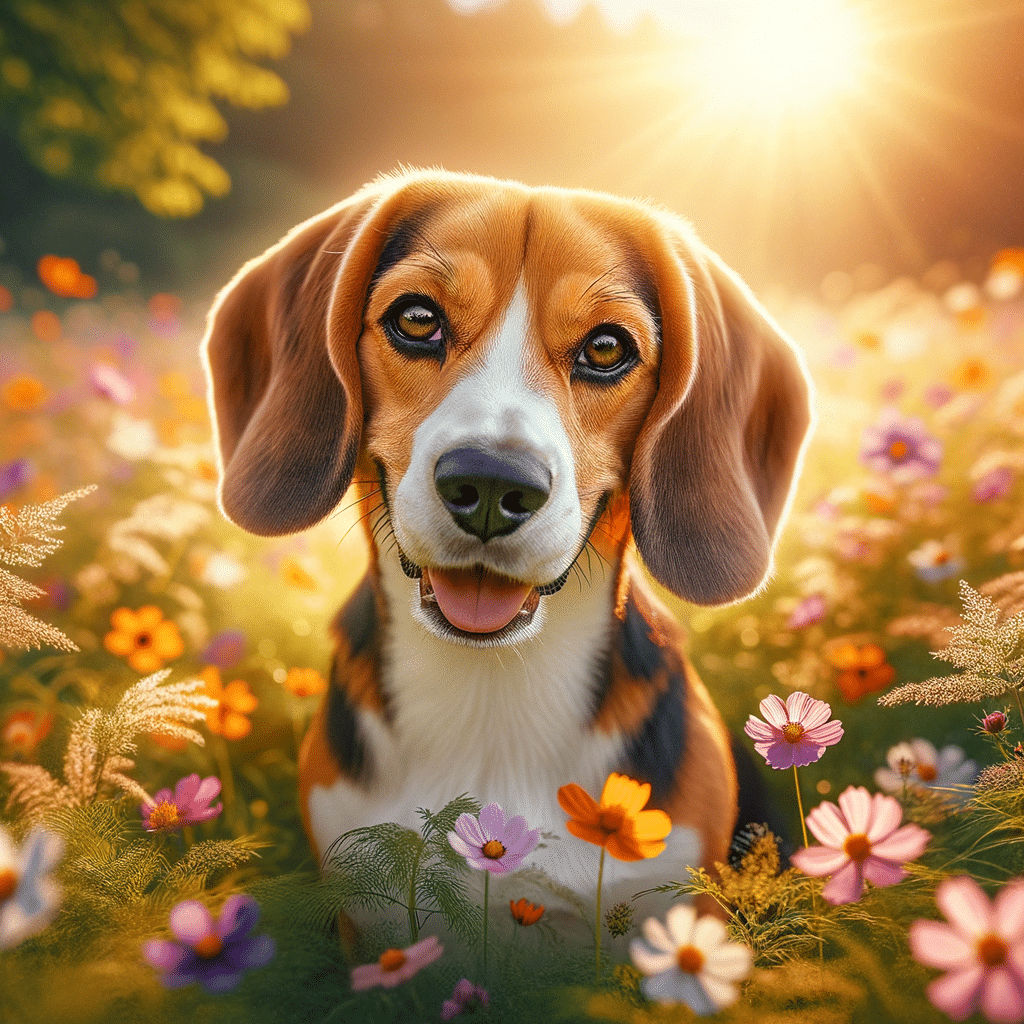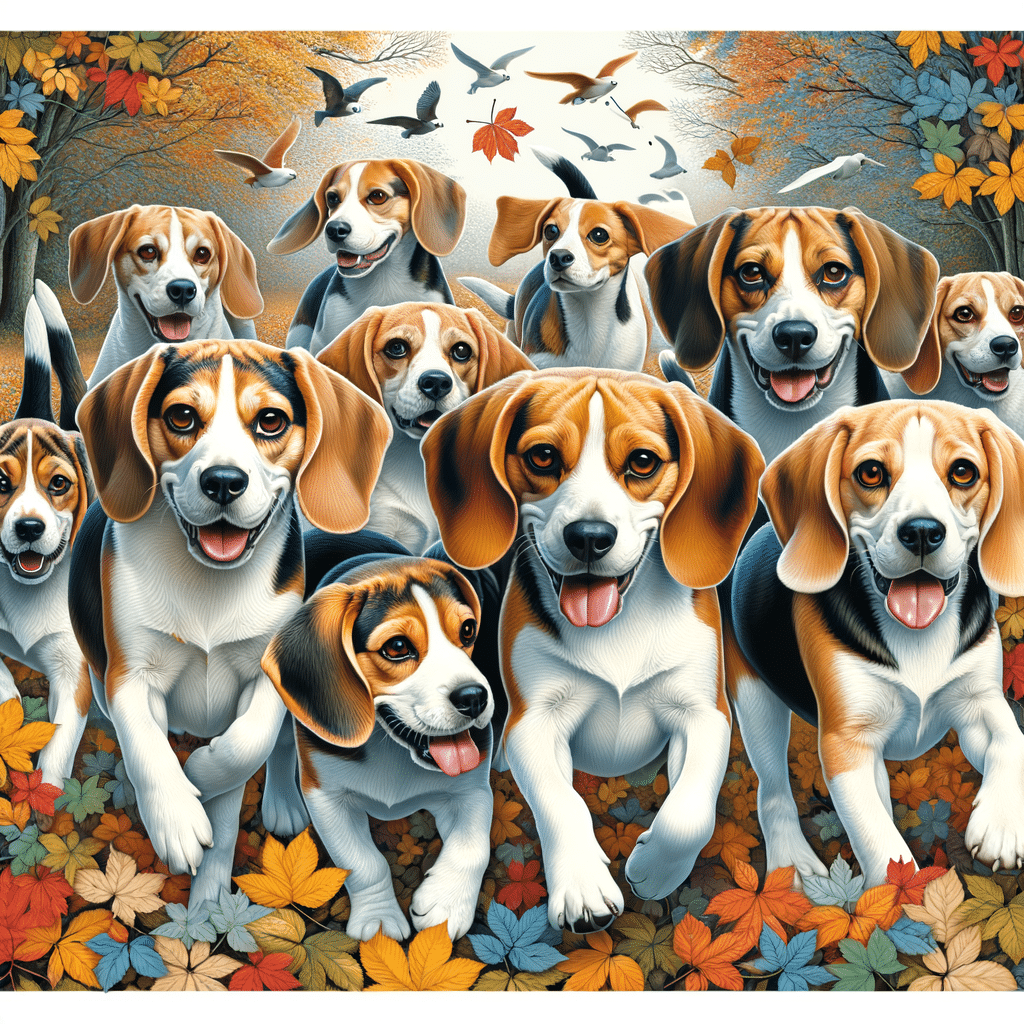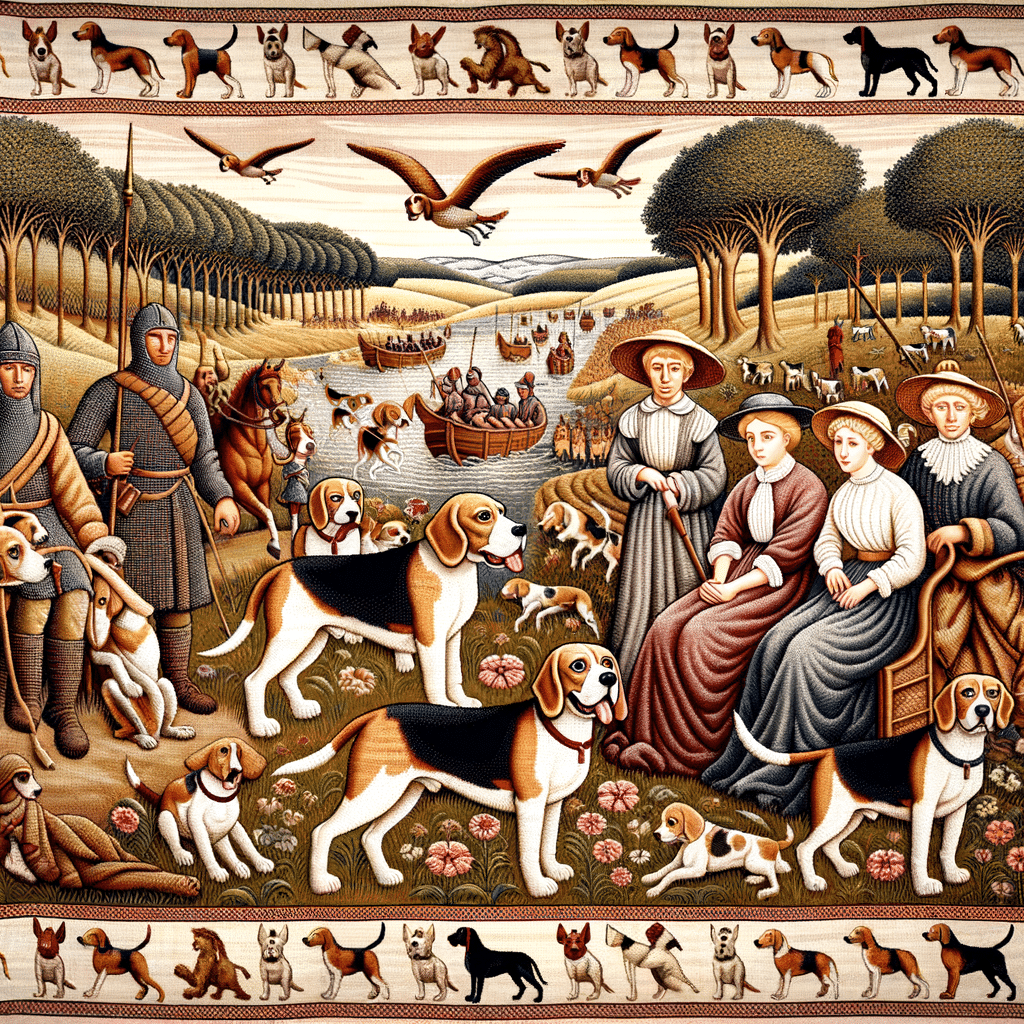Choosing the right dog breed can be a significant decision that requires a thorough understanding of your needs as a dog owner and the characteristics of each breed. Examining breed distinctions is extremely helpful when considering a beagle vs. a hound.
In This Article
The beagle and various hound dogs have great potential as family pets. Beagles are a distinct breed within the hound group, known for their compact size and friendly demeanor, whereas hound is a broader term that includes many larger-sized breeds with varied characteristics.
Understanding the differences between a beagle and other hound breeds involves examining their origins, physical traits, and temperaments. Beagles have a history of being excellent scent hounds, used primarily for hunting small game with a keen sense of smell and tracking instinct. On the other hand, breeds classified as hounds can include scent and sight hounds, each with unique qualities for different hunting and activities.
Highlights
- Beagles are smaller, friendly scent hounds suitable for family life.
- Hound breeds encompass a wider range of sizes and hunting skills.
- Choosing between a beagle and a hound depends on the prospective owner’s lifestyle and space.
Origins and History
The beagle and various hound breeds boast long and distinct histories, marked by their development for specific tasks and their esteemed presence in the cultures from which they originated. Dating back centuries, each breed reflects a unique journey from its origin to the present day.
Beagle Origin
England is credited with developing the modern beagle. Its origins date back to the era of Elizabeth I, when smaller hounds akin to the beagle, known as pocket beagles, were favored for hunting. The breed further evolved by incorporating traits from the harrier and possibly the Spanish pointer to improve its hunting prowess.
Hound History
Hounds, as a category, have been hunters since ancient times, thanks to their keen sense of smell and stamina. Breeds like the bloodhound and greyhound have been distinguished since medieval England. The foxhound, including the American and English foxhound, was developed through careful breeding practices to target specific quarries, particularly foxes. The black and tan coonhound, an American breed, showcases George Washington’s role in creating certain hound types.
Diverse hound Breeds
The hound group comprises various breeds, each with a specific role in hunting and tracking:
- Bloodhound: Renowned for its incredible scenting abilities, often used in tracking.
- Greyhound: One of the oldest breeds, known for its remarkable speed.
- Dachshund: Bred in Germany for hunting badgers; its short legs allow it to enter burrows.
- Basset hound: Possesses a formidable sense of smell, second only to the Bloodhound.
- Deerhound: Bred for coursing deer, featuring speed and agility.
- American foxhound & English foxhound: Originating in England, they were refined in America and England, respectively.
Through the years, each breed has been meticulously shaped by human needs and cultural influences, leading to the diverse and specialized hound breeds we know today.
Physical Characteristics
When comparing beagles and hounds, consider their distinct physical attributes that cater to their specific roles as scent hounds.
Size and Appearance
Beagles are small to medium-sized dogs, typically standing 13-16 inches tall at the shoulder and weighing 18-30 pounds. They possess a sturdy and compact frame suited to endurance rather than speed. The beagle’s coat is often a combination of white, black, and tan, with numerous other color variations and patterns, such as lemon, red, white, and tricolor. The coat is short, generally smooth, and weather-resistant, requiring minimal grooming.
While some facial features and coat texture are similar, basset hounds are larger than beagles. They have a distinctive appearance and a heavier bone structure, leading to a heavier weight range of about 40-65 pounds. With an average height of 14-15 inches at the shoulder, what they lack in stature, they make up for in bulk. Their short legs and longer body give them a unique silhouette among scent hounds.
Unique Traits
Both beagles and basset hounds have physical features advantageous for their original purpose – hunting. Their nose is one of their most defining features, having a powerful sense that is key for tracking. Their prey drive is noticeable, inherited from their roles as scent hounds.
An affectionate, energetic expression and a love for companionship mark the beagle’s appearance. This makes them an amiable choice for a family pet. Moreover, their moderate size and adaptability lend themselves well to various living situations.
Basset hounds share the affectionate nature of the beagle but are less energetic. Their droopy eyes and long ears add to a look many describe as endearing, making them beloved companions. Basset hounds’ unique physical characteristics, particularly their short and sturdy legs, contribute to a methodical and relentless tracking method.
Personality and Temperament
One must consider their distinct personalities and temperaments when comparing beagles to other hound dogs. These aspects profoundly influence their suitability as family pets, adaptability to changing circumstances, and overall behavior.
Behavioral Traits
Beagles
- Friendly: beagles are known for their friendly disposition.
- Curious: They display a high level of curiosity due to their hound heritage.
- Vocal: Their propensity to howl and bark can signify their inherent communicative nature.
Hound Dogs
- Loyal: hound dogs are typically loyal and form strong bonds with their owners.
- Independent: They may show independent behavior, sometimes mistaken for stubbornness.
- Diverse: hound dogs come in various breeds, each with distinct behaviors, from the vigilance of a Bloodhound to the high energy of a Greyhound.
Family and Lifestyle Compatibility
Beagles
- Children & families: They typically get along well with children, making them an excellent choice for families.
- Adaptability: Their smaller size and adaptive nature make them suitable for houses and apartments.
Hound Dogs
- Space requirements: Larger hound breeds may need more space and are better suited to homes with yards.
- Activity matching: The compatibility of hound dogs with families often depends on matching energy levels.
Exercise and Training
Beagles
- Exercise needs: Require moderate exercise to manage their energy levels and prevent destructive behavior.
- Intelligent but stubborn: Beagles are bright and trainable, but due to their stubborn streak, they may require patience and consistent training sessions.
Hound Dogs
- Training: Training demands vary widely among scent hound breeds, but they are generally intelligent and benefit from positive reinforcement.
- Energy and exercise: High-energy hound dogs need extensive daily exercise to maintain their health and behavior, including dog sports.
Health and Care
When considering a beagle’s or a hound’s health, prospective dog owners should know each breed’s specific health considerations, grooming needs, diet, exercise regimens, and overall lifestyle fit. Understanding these elements is crucial in providing the best care and ensuring a happy, healthy life for these dogs.
Common Health Concerns
Beagles and hounds are generally healthy but prone to certain breed-specific health issues. Beagles may suffer from hip dysplasia, a condition where the hip joint doesn’t fit properly, which can lead to arthritis. They also tend to get ear infections due to their floppy ears, which can trap moisture. Hounds, particularly basset hounds, are susceptible to similar concerns and may experience gastric problems such as bloat.
Maintenance and Grooming
Grooming needs for both breeds are fairly straightforward and low maintenance. Beagles have a short coat that requires regular brushing to minimize shedding, while hounds, with a similarly short coat, need occasional grooming to keep them clean. Both breeds demand regular ear checks to prevent infections in their long, floppy ears. Bathing should be done as needed but not so frequently as to strip the coat of natural oils.
Nutrition and Exercise
Beagles and hounds have moderate to high energy levels and thus require an appropriate diet that caters to their exercise needs. They should be fed high-quality dog food that provides balanced nutrition.
Daily exercise is essential for both breeds; beagles are energetic and enjoy activities, while Basset hounds are less active but still need regular walks to prevent obesity. These hunting dogs often have a strong prey drive, so you should secure optimal areas for off-leash exercise.
Living With a Beagle or Hound
Both beagles and hounds are known for being excellent companions and fit well into family life. They are typically dog-friendly and can live well with other pets, given proper socialization. You should prepare for the characteristic baying of these breeds, which can be loud. Adaptation to the owner’s active or more relaxed lifestyle can be smooth, provided they receive enough mental stimulation, affection, and playful interaction.
Frequently Asked Questions
When considering a beagle versus other hound breeds, consider temperament and suitability for living situations to make an informed decision.
What are the critical differences in temperament between beagles and other hound breeds?
Beagles are known for their friendly and curious nature. They are often more outgoing and interactive with humans than some other hound breeds. Other hounds, like the bloodhound, deliver a calmer and more reserved temperament, focusing intently on scent-tracking.
How does the size of a beagle compare to other hound dog breeds?
Beagles are generally small to medium-sized dogs, typically standing about 13 to 15 inches tall at the shoulder. This contrasts with larger hounds like the English Foxhound, which can stand 24 inches tall, showcasing the size range within the hound category.
Are beagles considered more suitable for house living when compared to larger hounds?
Due to their smaller size and adaptable nature, beagles are better suited for living in houses, including those with limited space. Larger hounds may require more room to move and exercise, which can be challenging in smaller living environments.
Before choosing between a beagle and another hound breed, what should a beginner dog owner know?
As a beginner dog owner, you should know that beagles are generally friendly, require moderate exercise, and respond well to training, making them a suitable choice for first-time owners. Other hound breeds might need more specialized attention or higher levels of activity.
How do beagles and basset hounds differ, and are they related breeds?
Beagles and basset hounds are related and are part of the hound family. They’re both bred for hunting purposes. Key differences include the basset hound’s distinctive long body and short legs, contrasting with the beagle’s more balanced proportions. Basset hounds also have a more solemn appearance and a more laid-back nature.
What characteristics make beagles a friendly breed compared to other hounds?
Beagles are one of the friendlier hound breeds because they offer sociability and a love of companionship. They enjoy being part of a family and are known for their playful nature, which endears them to many dog lovers compared to the more independent demeanor of some hounds.






